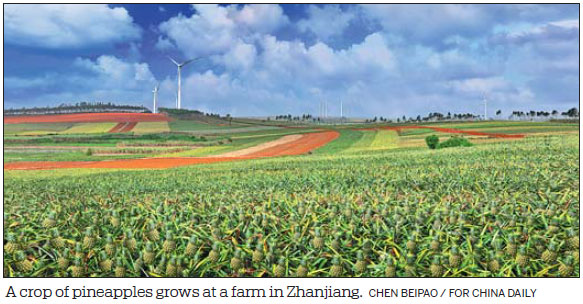Home> News
New villages with an industrial focus planned to fight poverty
Zhanjiang will build 40 villages that feature distinctive agriculture, ecology, folk culture and architecture by the end of this year, in an effort to revitalize the rural economy and improve the living standards of farmers, said Mayor Jiang Jianjun.
The pilot project will also allow local villagers to participate in and benefit from a rural program that will combine recycling, innovative agriculture and traditional farming experience, the mayor noted.
"We are conducting the experiments to combine agriculture with tourism," Jiang said.
Located on the Leizhou Peninsula in South China, Zhanjiang is one of the cities in Guangdong province that have the toughest job to relieve poverty.
According to official figures, the city has 218 poverty-stricken villages with a population of 240,000, accounting for one-seventh of the province's total.
"It has been a thorny problem that development in urban and rural areas is unbalanced, but we are considering ways to turn the problem into opportunities that help all the poor people to live well-off lives," Jiang said.
In another attempt, the city government encourages the county and township administrations to put the poverty-relief fund into industrial projects for poverty alleviation. This would develop a unique industry in each town and grow different products in each village, said the mayor.
"Every person from the poor families, who has working ability, can find a job with these projects. This will be more efficient way to pull them out of poverty," he said.
Since the peninsula has a long farming history, the local government focuses resource to develop several State and provincial-level agriculture demonstration areas and foster a group of strong agricultural companies to lead agricultural development.
For example, it has a State-level pineapple farm in Xuwen and a dragon fruit plantation in Suixi.
Agricultural output of Zhanjiang rose 5.5 percent year-on-year to 78.8 billion yuan ($11.7 billion) in 2018. Meanwhile, grain yield increased by 3.8 percent to nearly 1.5 million metric tons, according to the official figures.


 Print
Print Mail
Mail 5G construction supports Zhanjiang's high-quality development
5G construction supports Zhanjiang's high-quality development
 Acting mayor inspects project construction in Xuwen, Leizhou
Acting mayor inspects project construction in Xuwen, Leizhou Zhanjiang island an "egret paradise"
Zhanjiang island an "egret paradise"  Dancing egrets add vitality to Xiashan
Dancing egrets add vitality to Xiashan